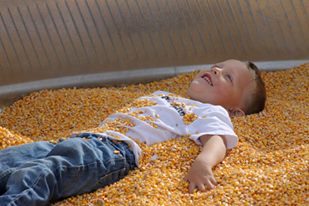By Kerri Rempp, Northwest Nebraska Tourism Director
Throughout history, generations have learned about those who came before through song, stories and art. Nowhere are those traditions more imperative than in the Native American culture. Plains Indians who populated what is today known as Northwest Nebraska passed their traditions from one generation to the next.

Today, artist Joe Pulliam continues the custom of his ancestors as he creates ledger art. Ledger art takes its name from the source of paper Native Americans began to use as European settlement moved westward. As tribes came into possession of ledgers, ink and pens, their artists expanded their craft, which had primarily consisted of using bone fragments and earth pigments to paint on shields and robes.
“This really represented the next step in art,” Pulliam said. “They were adapting to new materials.”
A native of Pine Ridge, Pulliam worked as a graphic designer for 10 years before learning about the connection of his people to ledger art after being introduced to the medium by Nebraska artist Daniel Long Soldier.
“The historical aspect of ledger art drew me to it,” Pulliam said during a recent stint as the artist-in-residence at the Mari Sandoz High Plains Heritage Center in Chadron.
When Pulliam discovered his great-great-uncle, Amos Bad Heart Bull, had been a prolific ledger artist, it cemented his decision to carry on the tradition. Bad Heart Bull’s father served as the historian for the Oglala Lakota and after becoming a scout for the U.S. Army, which included time at Fort Robinson, Bad Heart Bull followed in his father’s footsteps detailing the history of his people. According to Northern Plains Reservation Aid, Bad Heart Bull created 415 ledger art drawings on used ledger pages over the course of 20 years. The drawings depict Oglala Lakota life before 1856, followed by the conflicts with the Crow from 1856-1875 and the Battle of Little Bighorn, in which his father fought.
Artist Joe Pulliam answers questions about his ledger art in front of a ledger art creation done by his great-great-uncle, Amos Bad Heart Bull.
Bad Heart Bull’s original pieces were buried with his sister, Dolly Pretty Cloud, but were documented by photographer Helen Blish, said Laure Sinn, of the Mari Sandoz High Plains Heritage Center. Staff at the center discovered Blish’s book in the center’s archives – a gift to Mari Sandoz at some point – and Bad Heart Bull’s connection with Northwest Nebraska and created the current gallery showing “Native American Legacies.” The show, which runs through Dec. 13, includes reprints of many of Bad Heart Bull’s ledger art pieces, as well as original creations by Pulliam.
Using Blish’s work as a focal point, the show also features Honoring Quilts donated by Roxie Puchner and a display calling attention to missing and murdered indigenous women. Blish herself has connections to the region, as her father, William, was assigned to work with the Oglala Sioux on the Pine Ridge Indian Reservation while employed with the Department of Interior’s Indian Bureau, according to History Nebraska. After graduating from college in 1922, Blish taught English in Gordon for a time before returning to her native Michigan. When it came time for her to write her master’s thesis, she began looking for examples of Plains art, an endeavor that led to her 1934 manuscript “A Photographic History of the Oglala Sioux” featuring Bad Heart Bull’s work.
Pulliam said research is a key part of his ledger art as he finds ways to preserve the culture and history.
“I’m exploring new ways to portray history in a modern light,” he said.
A piece he calls “Indigitized” represents Native American’s struggle with identity as they always have “one foot in history and one foot in the present,” Pulliam said. “Warrior Society” depicts fierce defenders in Oglala Lakota history who were also among the most generous people of the tribe, proving they were equally valuable in times of peace as they were in war. Pulliam hopes his art inspires the return of those values to society while additionally calling injustices to light, as he does in another piece inked on an 1892 Sheridan County land deed, to represent government-ignored treaties.
While his great-great-uncle used present-day ledgers for his creations, Pulliam scours the internet, antique shops, thrift stores and yard sales in search of ledgers to use in his work.
“The search is always on,” he said.
Pulliam is also active in social justice issues and is a supporter of the White Clay Maker Space, an effort to provide economic sustainability to Lakota living in the area. A recovering alcoholic, Pulliam said while the maker space’s business-aspect is important, he is more focused on empowering himself and his people through art and providing the healing he finds in the creative process.

This ledger art drawing of the Battle of Little Big Horn was done by Amos Bad Heart Bull.

This ledger art creation by Joe Pulliam is produced on an 1897 Sheridan County land deed.

Joe Pulliam shows a visitor to the Mari Sandoz Center a book of ledger art pieces by the Cheyenne Dog Soldiers, some of the premier Native American ledger artists.

On the left, Joe Pulliam’s Warrior Society ledger art creation is contrasted with his work on the right, drawn on a sheet of music. “When I look at music, I see art,” Pulliam said.

Joe Pulliam served as the artist-in-residence at the Mari Sandoz High Plains Heritage Center in November.

In addition to Amos Bad Heart Bull’s ledger art, pieces by Joe Pulliam are also on display until Dec. 13, 2019, at the Mari Sandoz Center.




